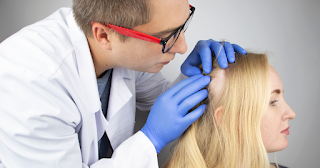Alopecia Areata Awareness Month: Understanding, Supporting, and Advancing Research

Alopecia Areata Awareness Month |
What is Alopecia Areata?
Alopecia areata is an autoimmune condition where the body’s immune system mistakenly attacks hair follicles, leading to hair loss. This hair loss can occur anywhere on the body but is most commonly seen on the scalp and face. The condition varies in severity, from small, round patches of hair loss (alopecia areata) to complete scalp hair loss (alopecia totalis) or even total body hair loss (alopecia universalis). The cause remains unknown, but genetic and environmental factors likely play a role (NIAMS).
Symptoms and Diagnosis
The hallmark of alopecia areata is sudden, patchy hair loss. The affected areas may be smooth and round, and some individuals may experience changes in their nails, such as pitting or ridges. Diagnosis typically involves a clinical examination, and in some cases, a biopsy or blood tests to exclude other conditions. The progression and pattern of hair loss can vary, with some individuals experiencing regrowth and others having a more persistent or relapsing course.
Treatment Options
Currently, there is no cure for alopecia areata, but various treatments can help manage the condition and stimulate hair regrowth. Options include topical or injectable corticosteroids, immunotherapy, and oral medications like JAK inhibitors. The effectiveness of these treatments can vary, and many individuals may explore cosmetic solutions such as wigs, hairpieces, or makeup to cover affected areas .
The Color of the Campaign
The official color for Alopecia Areata Awareness Month is blue. This color symbolizes strength, resilience, and the collective support for those affected by the condition. Throughout September, advocates and supporters wear blue, share blue-themed content on social media, and participate in various activities to show solidarity and raise awareness. The choice of color helps unify the community and visually represents the campaign’s message of understanding and support .
National Alopecia Areata Foundation (NAAF): Initiatives and Campaigns
The National Alopecia Areata Foundation (NAAF) is a pivotal organization dedicated to supporting individuals with alopecia areata. Established in 1981, NAAF provides comprehensive resources, including support groups, educational materials, and advocacy efforts. The foundation funds research aimed at understanding the condition and developing effective treatments. NAAF’s initiatives also include organizing events and campaigns, such as Alopecia Areata Awareness Month, to foster community support and awareness.
Key Initiatives and Actions
-
Support and Advocacy:NAAF offers a range of support services, including local support groups and educational programs, to help those affected navigate their experiences and advocate for their needs.
-
Research Funding:The foundation supports numerous research projects and clinical trials, including studies on genetic predispositions and potential therapeutic options, like JAK inhibitors.
-
Awareness Campaigns:NAAF spearheads campaigns such as Alopecia Areata Awareness Month, encouraging public participation in spreading awareness and understanding of the condition.
-
Annual Conferences and Events:These events provide a platform for sharing knowledge, experiences, and the latest research findings, fostering a sense of community and collective advocacy.
Leading Research Institutions and Global Efforts
In addition to NAAF, several global institutions are dedicated to advancing research and treatment options for alopecia areata:
-
NIAMS, a division of the NIH, plays a critical role in researching alopecia areata and funding studies, including clinical trials exploring new treatments like JAK inhibitors.
-
UCSF is involved in several clinical trials and maintains a registry for collecting data from affected individuals. Their research includes exploring the safety and efficacy of new drugs.
-
Sun Pharma is actively involved in developing and distributing treatments for alopecia areata, including the JAK inhibitor Leqselvi™ (deuruxolitinib).
-
The Icahn School of Medicine at Mount Sinai conducts groundbreaking research, particularly in pediatric alopecia areata, exploring treatments like dupilumab.
-
This UK institution is renowned for its research into the genetic and immunological aspects of alopecia areata, working towards better understanding and treatment.
-
Researchers at Nagoya University in Japan contribute significantly to the global understanding of alopecia areata, focusing on genetic factors and potential therapeutic interventions.
Conclusion
Alopecia Areata Awareness Month is a crucial time for raising awareness, fostering understanding, and supporting those affected by the condition. Through the collective efforts of organizations like NAAF, global research institutions, and the broader community, significant strides are being made in understanding and treating this challenging condition. By spreading awareness and supporting ongoing research, we can work towards a future where those affected by alopecia areata have access to effective treatments and compassionate support.
